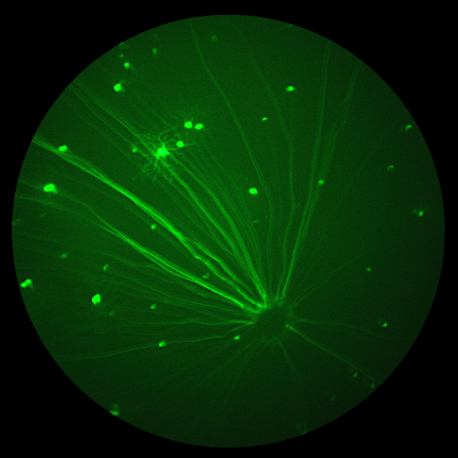In their 2019 paper, “Novel molecular mechanisms for Prph2‐associated pattern dystrophy,” Chakraborty et al use the Phoenix MICRON® IV retinal imaging platform to longitudinally study the effect of a very specific mutation affecting the Peripherin 2 protein. Peripherin 2 is a protein in rods and cones which, if mutated, can lead to retinitis pigmentosa, cone-rod […]
29.09
2020
RPE mutations lead to retinal hypopigmentation, vasculature changes, and decreased function
In their paper, “The microphthalmia-associated transcription factor (Mitf) gene and its role in regulating eye function,” García-Llorca et al use the Phoenix MICRON® IV to examine the outer eye appearance, retinal pigmentation, and retinal vasculature through fluorescein angiography to study several different mouse mutants. Combined with electroretinography and histology, the fundus images tell a story […]
26.08
2020
Phoenix MICRON® III shows microglia-like cells migrating from the optic nerve after injury
Microglia respond to neurological injury but the precise way they help to clear and remodel the injuries is not known. In their paper, “Optic nerve as a source of activated retinal microglia post-injury,” Heuss et al investigate a population of microglia-like cells that proliferate in the retina after an optic nerve injury. They identify GFPhi myeloid […]
21.07
2020
Caspase-9 inhibiting eyedrops rescue physiological and functional retinal vein occlusion damage shown with Phoenix MICRON®, OCT, and focal ERG
In a recent well written, compelling article published in Nature Communications, “Endothelial activation of caspase-9 promotes neurovascular injury in retinal vein occlusion,” Avrutsky et al show that caspase-9 inhibition is a promising treatment for retinal vein occlusion. Retinal vein occlusion models hypoxic-ischemic neurovascular damage and is the second leading cause of blindness in working-age adults. […]
18.02
2020
Retina as window to the brain: Stunning Phoenix MICRON® fluorescein angiography images of brain and retinal vasculature
Novel comparison of retina and brain vasculature leads to stunning Phoenix MICRON® images of fluorescent brain blood vessels The Phoenix MICRON® imaging platform produces stunning images of fluorescent retinal vasculature through fluorescein angiography but for the first time, researchers have also captured beautiful images of cortical brain vasculature. Hui et al, in their well-written and […]
30.01
2020
Measuring adeno-associated virus improvements with Phoenix MICRON® fluorescent imaging and Phoenix MICRON® Ganzfeld ERG
A team of researchers at the Indian Institutes of Technology have published three detailed articles examining how to improve adeno-associated viruses (AAV). Maurya, S, Mary, B, Jayandharan, GR et al -approach the improvement of the viruses in a stunningly detailed gene-to-cell-to-whole-mouse model, narrowing down a multitude of options and producing impressive fluorescent fundus images and […]




